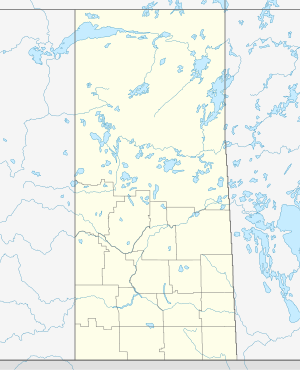Robsart, Saskatchewan
Robsart, Saskatchewan | |
|---|---|
Hamlet of Robsart, Saskatchewan | |
| Country | |
| Province | |
| Region | South west, Saskatchewan |
| Census division | Division No. 4 |
| Post office Founded | 1912 |
| Village established | 1910 |
| Government | |
| • Former Mayor | Archie Smiley |
| Area | |
• Total | 500.488 km2 (193.239 sq mi) |
| Population (2001) | |
• Total | 95.0 |
| Time zone | CST |
| Postal code | S0N 2G0 |
| Area code | 306 |
Robsart is a small hamlet in the southwestern located on highway 13, about 50km east of the Alberta, Saskatchewan border and is about 175km south west of Swift Current.
Demographics
History
In 1910, Canadian Pacific Railroad (CPR) purchased a quarter section of land in southwest Saskatchewan and called it Robsart. The land was named after Amy Robsart, from the Sir Walter Scott book, Kenilworth. Three years after the land was bought a man named Henry Abbott led the first settlers to the new community, shortly after their arrival, businesses started to go up quickly. Two of the first Businesses were a general store and feed mill. Following them were 30 other businesses, including a dentist, jeweller, and a surgeon.
In 1914 the arrival of the railroad brought even more prosperity for the small prairie community. New businesses were opening almost weekly, bringing new hotels, cafes, churches, livery barns, schools, a banks, grain elevators, and a few years later its very own hospital. The town was so prosperous that were postcards of the town telling that Robsart was “A town with a bright future.”
<gallery>
Ten years after the town of Robsart was established it had a population of 350 residents, it’s own town hall, mayor, town council, and around more than 50 businesses.
In the late twenties Robsart's explosive prosperous beginnings began its long decline. A grain elevator fire in 1929 was an ominous sign of things to come. The following year saw another blaze wipe out a large section of the business core.
The Depression years, with accompanying droughts, falling grain prices and poor crop yields, witnessed further business closures. Many merchants, staggered by crippling financial losses, packed and left for greener pastures.
The beleaguered community struggled on but never with the same early pioneer optimism. Locals and nearby farmers rallied in the eighties to renovate a new community hall but slowly, one by one, most remaining businesses and homes were boarded up. By the end of 2000, only half a dozen people were left in the town. Prairie phantoms had clearly taken over.
See also
External links

